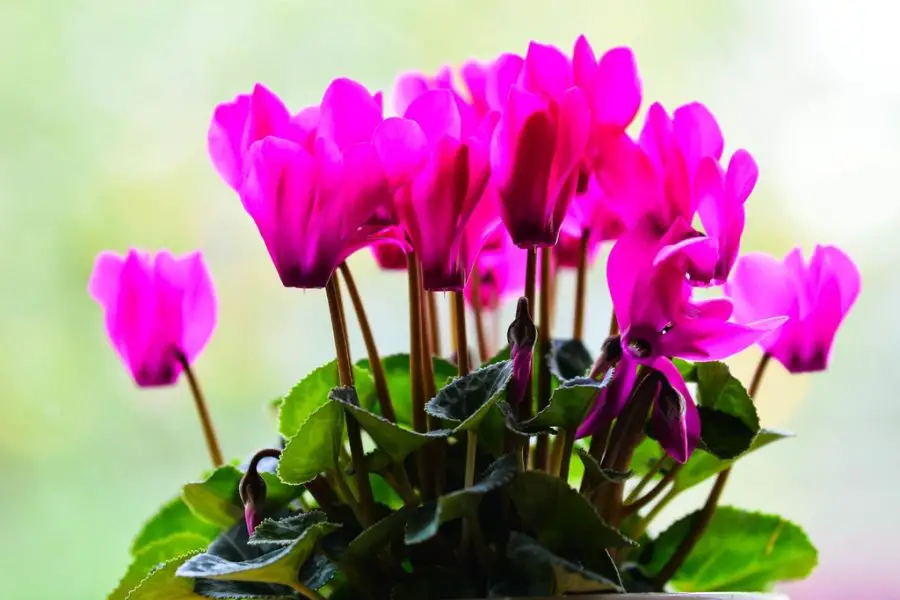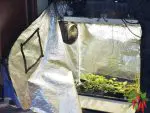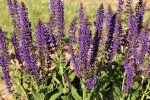This post contains affiliate links. If you buy something from one of our links we may earn a commission. Thanks

Discover the secrets to Cyclamen indoor care for vibrant blooms and healthy heart-shaped leaves. Expert tips and tricks inside!
Cyclamen indoor care requires a cool, well-lit space away from direct sunlight and radiators. Water the plant from below to avoid wetting the leaves, and let the soil slightly dry out between waterings. During active growth, feed with a balanced liquid fertilizer every two weeks. Reduce watering during dormancy.
If you’re looking for a plant that will add color and life to your home during the cooler months, Cyclamen indoor care is definitely something to consider.
With their vibrant flowers and heart-shaped leaves, Cyclamen plants are a beautiful addition to any indoor space.
But don’t let their delicate appearance fool you! Proper care is essential to keep these plants healthy and thriving.
In this guide, we’ll reveal the secrets to caring for your indoor Cyclamen so you can enjoy their beauty all year round.
An Introduction To Cyclamen Indoor Care
Are you ready to take your Cyclamen plant experience to the next level?
Whether you’re a seasoned green thumb or a beginner, learning about Cyclamen indoor care will ensure that your plant thrives in any environment.
In this post, we’ll explore the best ways to care for your Cyclamen indoors, including lighting, watering, soil, and propagation.
We’ll also discuss common problems you may encounter and how to solve them.
So grab your watering can and let’s get started!
A brief overview of Cyclamen indoor care
Cyclamen plants are a popular choice for indoor gardening, thanks to their vibrant flowers, heart-shaped leaves, and low-maintenance needs.
But to ensure your plant thrives, you need to give it the right care. In this blog post, we’ll cover all the essential aspects of Cyclamen indoor care, so you can enjoy the beauty of this plant for years to come.
Importance of proper care for indoor Cyclamen plants
Like any other plant, Cyclamen requires proper care to thrive indoors.
Neglecting your plant can result in yellow leaves, dead foliage, and even death.
With the right care, however, you can enjoy lush greenery and vibrant flowers throughout the growing season.
Overview of topics to be covered in the blog post
In this blog post, we will cover everything you need to know to care for your indoor Cyclamen.
Topics we’ll cover include the best growing conditions, watering and fertilization tips, soil requirements, propagation methods, and how to deal with pests and diseases.
We’ll also cover how to care for outdoor Cyclamen and what to do during the dormant period.
By the end of this post, you’ll have all the knowledge you need to keep your Cyclamen healthy and vibrant.
Cyclamen indoor or outdoor
Are you wondering whether to grow your cyclamen indoors or outdoors?
This is a common question among new cyclamen plant owners, and the answer is not as straightforward as one might think.
While some species of cyclamen thrive in outdoor environments, others are better suited to indoor conditions.
In this section, we will explore the factors to consider when deciding whether to grow your cyclamen indoors or outdoors.
Cyclamen plants are a beautiful addition to any home or garden, but deciding whether to grow them indoors or outdoors can be a tough choice.
Indoor cyclamen plants, often known as florist’s cyclamen, are a popular choice for their vibrant flowers and compact size.
However, outdoor species, such as Cyclamen hederifolium and Cyclamen coum, are hardy and can withstand cooler temperatures.
When deciding between indoor or outdoor placement, there are several factors to consider, including the temperature and humidity levels, available light, and the space available for the plant to grow.
Let’s explore these factors in more detail.
Explanation of the differences between indoor and outdoor cyclamen plants:
Cyclamen plants are native to the Mediterranean region, where they grow in cool, moist conditions.
When grown indoors, they require cooler temperatures and more humidity than many other houseplants.
In contrast, outdoor cyclamen plants can tolerate colder temperatures, but they also require well-draining soil and protection from frost.
Factors to consider when deciding between indoor or outdoor placement:
When deciding whether to keep your cyclamen plant indoors or outdoors, there are several factors to consider.
These include the climate in your area, the amount of light your plant will receive, and the level of care you are willing to provide.
For example, if you live in a region with mild winters, you may be able to keep your cyclamen outdoors year-round.
However, if you live in an area with harsh winters, it may be best to keep your plant indoors during the colder months.
Additionally, if you have limited space or prefer the convenience of indoor gardening, growing your cyclamen as a houseplant may be the best option for you.
What Species Is Florest Cyclamen?
The species commonly sold by florists is Cyclamen persicum, which is typically grown as a houseplant.
What Are Some Common Species Grown Outdoors?
Some of the common species of cyclamen that are grown outdoors are Cyclamen coum, Cyclamen hederifolium, Cyclamen purpurascens, and Cyclamen repandum.
Cyclamen In Pots Indoors
Bringing the beauty of cyclamen indoors is a great way to add some color and life to any living space.
Growing cyclamen in pots is a popular choice for indoor gardeners, as it allows for easy maintenance and provides a stunning display of vibrant flowers.
In this section, we will explore the essentials of growing cyclamen in pots indoors, from selecting the right pot and soil to proper watering and fertilizing techniques.
Tips for choosing the right pot for indoor cyclamen plants:
When choosing a pot for your indoor cyclamen, it’s important to consider the size and depth of the pot.
The pot should be deep enough to accommodate the tuber, with enough space for the roots to spread out.
It’s also recommended to choose a pot that is wider than the tuber, which will allow for good air circulation and room for new growth.
Importance of a drainage hole:
Drainage is crucial for indoor cyclamen plants, and it’s important to choose a pot with a drainage hole to prevent excess water from sitting in the soil.
Cyclamen plants are sensitive to overwatering and can develop root rot if left in waterlogged soil.
To ensure proper drainage, it’s recommended to add a layer of gravel or broken pot shards to the bottom of the pot before adding soil.
The best soil for indoor cyclamen plants:
Cyclamen plants thrive in well-draining soil that is rich in organic matter.
A recommended soil mix is a combination of coco coir and perlite, which provides good drainage and retains moisture.
Coco coir is a sustainable alternative to peat moss, which can have negative environmental impacts.
It’s important to avoid heavy, clay soils that can retain too much moisture and suffocate the roots of your indoor cyclamen plant.
Cyclamen Indoor Care Light
When it comes to indoor cyclamen care, lighting is an essential factor that can make or break your plant’s growth and blooming.
In this section, we will delve into the ideal lighting conditions that your indoor cyclamen plant requires and how to achieve them.
Optimal light conditions for indoor cyclamen plants:
Cyclamen plants need the right amount of light to grow and thrive indoors. Too much light or too little light can cause problems for these beautiful plants.
The difference between direct and indirect sunlight:
Direct sunlight can be harmful to cyclamen plants, as it can burn the leaves and cause damage.
On the other hand, indirect sunlight can provide the right amount of light without causing damage.
Tips for providing the right amount of light:
To provide the right amount of light for indoor cyclamen plants, it is best to place them in a bright spot with indirect sunlight, such as near a window that gets plenty of natural light.
If the plant starts to stretch or lean towards the light, it may need to be moved closer to the window or provided with additional light sources, such as grow lights.
Using led grow lights to supplement low light indoors
You can use LED grow lights to supplement low light conditions for your indoor cyclamen plants.
When selecting grow lights, look for full-spectrum LED lights that mimic natural sunlight.
Position the lights about 24 inches above the plants but it’s best to follow the manufacturer’s directions.
Keep them on for 12-16 hours a day.
Be sure to adjust the lights as your plants grow to maintain the proper distance.
LED grow lights can be a great option for providing the right amount of light for your indoor cyclamen plants, especially during the winter months or if you don’t have access to natural light.
Cyclamen Watering
Are you worried about over or under-watering your indoor cyclamen plant? Watering is an important aspect of Cyclamen indoor care.
In this section, we’ll go over everything you need to know about watering your cyclamen plant to ensure it stays healthy and vibrant.
From how often to water, to the right amount, to the best ways to water, we’ve got you covered. So, let’s dive in!
A happy cyclamen plant is a well-watered one, but finding the right balance can be tricky.
Overwatering or underwatering can both lead to unhappy plants. In this section, we’ll cover the importance of proper watering for indoor cyclamen plants.
We’ll discuss how often to water your plant, and we’ll look at the signs that your plant is getting too much or too little water.
With a little bit of knowledge, you can ensure that your cyclamen plant stays hydrated and healthy.
Details for proper watering
Proper watering is crucial for the health of indoor cyclamen plants.
Overwatering can lead to root rot, while underwatering can cause the plant to wilt and die.
As a general rule of thumb, it’s best to water the plant when the soil feels dry to the touch, but not bone dry.
When watering, it’s important to water thoroughly until excess water drains out of the bottom of the pot, but avoid letting the plant sit in standing water.
Additionally, it’s best to use room temperature water rather than cold water straight from the tap, as the temperature shock can harm the plant.
Be sure to water the soil directly, rather than the leaves, to prevent disease.
Cyclamen Soil
Are you curious about the best soil for your indoor cyclamen plant?
In this section, we’ll discuss why coco coir and perlite are preferred over traditional potting soil or peat.
We’ll also cover the importance of well-draining soil and how to ensure your cyclamen is growing in the right medium.
Best soil types for indoor cyclamen plants:
We recommend using a well-draining soil mix to avoid waterlogged soil that can harm your indoor cyclamen plants.
A soil mix containing coco coir and perlite is preferred over potting soil or peat moss as they tend to retain more moisture, which can cause the tubers to rot.
How to check the moisture level in soil:
It’s important to regularly check the soil moisture level for indoor cyclamen plants.
You can use a moisture meter or stick your finger about an inch deep into the soil to check if it’s dry or moist.
Tips for improving soil quality:
If you find that your soil is too dense or clay-like, mix in some perlite, sand, or vermiculite to improve drainage.
Adding organic matter such as compost or leaf mold can also improve soil quality and provide your indoor cyclamen plants with essential nutrients.
Cyclamen Propagation
Are you interested in expanding your collection of indoor cyclamen plants?
Propagation is an exciting way to create new plants from your existing ones.
In this section, we’ll explore the different methods of propagating cyclamen plants and give you some tips on how to do it successfully.
Whether you’re a beginner or a seasoned plant enthusiast, propagating cyclamen is a fun and rewarding experience. Let’s get started!
How to propagate indoor cyclamen plants:
Propagating cyclamen is a great way to create new plants from your existing ones.
Cyclamen plants can be propagated through seeds or by division. Propagation by division is the preferred method as it is less time-consuming and produces healthier plants.
Steps for successful propagation:
Propagation by division involves separating the corm (tuber-like structure) of the plant into smaller sections.
To do this, gently lift the plant out of its pot and carefully remove the soil around the corm.
Then, using a sharp knife or scissors, cut the corm into smaller sections, each containing at least one growing point.
Best time for propagation:
The best time for propagating cyclamen is during the early growing season in late summer or early autumn.
This is when the plant is actively growing and has enough energy to produce new growth.
Growing Cyclamen Seeds
Growing cyclamen from seeds is a great way to start a new collection or expand an existing one.
While it can be a bit challenging, the process can be very rewarding. Cyclamen seeds are typically available at garden centers or online.
You Can Buy Your Cyclamen Seeds Online At Amazon
• To get started, fill a shallow tray or pot with a well-draining seed starting mix.
• Sow the seeds on the surface of the mix, and gently press them into the soil.
• Keep the soil moist, but not waterlogged, and cover the container with a plastic bag to help retain moisture.
• Place the tray or pot in a bright spot, but out of direct sunlight.
• In a few weeks, you should start to see seedlings emerge.
• Once they have grown a few true leaves, you can transplant them into individual pots with potting mix.
Cyclamen Care Outdoor
If you’re lucky enough to live in a climate suitable for outdoor gardening, growing cyclamen outdoors can be a delightful addition to your garden.
However, it’s essential to provide the right conditions to ensure your plants thrive.
In this section, we’ll discuss the best practices for caring for outdoor cyclamen plants, including their preferred growing conditions, soil type, and watering needs.
Let’s dive in!
Introduction to outdoor cyclamen care
If you’re lucky enough to have an outdoor space for your cyclamen, it’s important to know the differences in care compared to indoor plants.
Outdoor cyclamen require specific conditions to thrive, but with the right care, they can produce beautiful blooms for years to come.
Differences between indoor and outdoor care
While indoor and outdoor cyclamen share some care requirements, outdoor plants require a bit more attention to thrive.
They prefer cool temperatures and high humidity, making them an ideal plant for shady spots in the garden.
Tips for successful outdoor cyclamen care
When it comes to outdoor cyclamen care, proper planting and soil conditions are key.
It’s important to choose well-drained soil and a spot with partial shade.
Providing regular watering, fertilization, and good air circulation will also help ensure your outdoor cyclamen plants stay healthy and vibrant.
Cyclamen In Pots
Cyclamen can be grown in pots both indoors and outdoors. In this section, we will discuss the benefits and considerations of growing cyclamen in pots outdoors.
We will cover topics such as choosing the right pot, selecting the best location, and providing proper care to ensure your outdoor cyclamen thrives in a container.
Whether you are looking to add some color to your patio or balcony or simply prefer the convenience of container gardening, growing cyclamen in pots outdoors can be a rewarding experience.
Choosing the right pot size and placement can make a big difference in the health and growth of your outdoor cyclamen plants.
The size of the pot can affect the amount of soil and nutrients available to the plant, as well as the root system and drainage.
It’s important to choose a pot that is large enough to accommodate the plant’s roots, but not so large that it retains too much moisture.
Additionally, the placement of the pot can impact the amount of sunlight and wind exposure the plant receives, as well as its temperature and moisture levels.
By selecting the right pot size and placement for your outdoor cyclamen plants, you can help ensure that they thrive and flourish in their environment.
Cyclamen Placement
In addition to selecting the right pot size, it’s also important to consider the placement of your outdoor cyclamen plants.
Cyclamen plants prefer partial shade, so it’s best to place them in an area where they can receive bright, indirect light for a few hours a day.
If your climate is very hot, it’s important to provide some protection from the direct sun, which can scorch the leaves and flowers.
In addition, cyclamen plants prefer cool temperatures, so placing them in a spot with good air circulation can help keep them from getting too warm.
When selecting a spot for your outdoor cyclamen plants, it’s important to consider these factors to ensure that they thrive.
What month do cyclamen go dormant?
Cyclamen are unique plants that follow a distinct growth cycle.
Dormancy is a natural part of this cycle that occurs during a specific time of the year.
If you’re wondering when cyclamen plants go dormant, you’ve come to the right place!
In this section, we’ll discuss the dormant period of cyclamen and what to expect during this time.
During their dormant period, cyclamen plants go through a period of rest where they stop growing and their leaves die back.
This usually happens during the late spring or early summer months. The best time for dormancy is when the leaves begin to yellow and dry up, signaling the end of the plant’s growing season.
To properly care for your cyclamen during this time, reduce watering and move the plant to a cool, dark spot with good air circulation.
It’s also important to avoid fertilizing your cyclamen during dormancy, as this can encourage new growth and disrupt the plant’s natural cycle.
With proper care during dormancy, your cyclamen will be ready to flourish in the next growing season.
Indoor Cyclamen Problems
Uh oh, have you noticed your indoor cyclamen plant isn’t looking as healthy as it once did?
Don’t worry, in this section, we’ll go over some common problems that can arise with indoor cyclamen plants and how to address them to keep your plant happy and thriving.
A healthy indoor cyclamen plant can brighten up any room, but sometimes they can experience problems that may impact their growth and overall health.
In this section, we’ll explore some common issues that may arise with indoor cyclamen plants and how to identify and treat them, including yellow leaves, brown patches, and other issues.
Additionally, we’ll cover some preventative measures to help you avoid indoor cyclamen problems altogether.
When it comes to indoor cyclamen plants, there are a few common issues that can arise.
Common problems with indoor Cyclamen plants
Common problems with indoor cyclamen plants can include yellow leaves, brown patches, and issues with fungal diseases like grey mold.
It’s important to identify the root cause of these problems in order to properly treat them.
For example, yellow leaves may be a sign of overwatering or underwatering, while brown patches could be caused by insect infestations or nutrient deficiencies.
It’s also important to take preventative measures to avoid these problems in the first place, such as ensuring proper watering and fertilization, providing good air circulation, and avoiding placing your plant near heat sources.
By understanding these issues and how to address them, you can keep your indoor cyclamen plants healthy and vibrant.
Cyclamen Pests And Diseases
Are you noticing your indoor cyclamen plant struggling despite your best efforts?
It may be suffering from a pest or disease infestation. In this section, we’ll discuss common pests and diseases that can affect cyclamen plants, how to identify them, and what you can do to treat and prevent them from spreading.
Let’s discuss some of the most common pests and diseases that can affect your indoor cyclamen plants, including spider mites, cyclamen mites, and grey mold.
We’ll cover how to identify these problems and provide you with some tips for treating and preventing them from causing further damage to your plants.
With the right care and attention, you can keep your indoor cyclamen plants healthy and thriving.
It’s important to be able to identify common pests and diseases that can affect your indoor cyclamen plants, as well as know how to treat and prevent them.
Spider mites, cyclamen mites, and grey mold are all common problems that can be especially harmful to your plants if not addressed promptly.
In this section, we’ll cover how to identify these issues, provide you with tips for treating them, and give you preventative measures to keep your plants healthy and thriving.
Common Cyclamen Pests
Spider Mites: These tiny insects are common pests that can be identified by the webbing they leave on leaves and buds. They can cause stunted growth and yellowing of leaves. To treat, you can wipe down the leaves with a damp cloth or spray with a neem oil solution.
Cyclamen Mites: These microscopic pests cause distorted growth and yellowing of leaves, often leading to plant death. Infected plants should be removed to prevent spreading.
Common Cyclamen Diseases
Grey Mold: This fungal disease can cause grey moldy patches on leaves and stems. It can be treated with a fungicide, but it’s important to maintain good air circulation and avoid getting the foliage wet.
Crown Rot: This disease can cause the plant to wilt and die, often due to overwatering or poor drainage. To treat, remove any affected leaves and improve drainage.
It’s important to keep a close eye on your cyclamen plants and regularly inspect them for any signs of pest or disease infestations.
Prompt identification and treatment can help prevent further damage and ensure your plants remain healthy.
Additionally, taking preventative measures such as proper watering, good air circulation, and avoiding over-fertilization can help reduce the risk of these issues in the first place.
Other insect pests?
There are a few other common insect pests that can affect cyclamen plants.
Thrips, for example, are tiny insects that can cause distorted leaves and flowers.
Mealybugs are another pest that can infest cyclamen, leaving a white, cottony residue on the leaves and stems.
Scale insects are also known to attack cyclamen, forming small, hard bumps on the leaves and stems.
In severe cases, all of these pests can cause significant damage to the plant, so it’s important to identify and treat them as soon as possible.
Treatments For Common Insect Pests And Diseases
Spider mites: Spider mites can be treated with insecticidal soap or neem oil spray.
You can also try wiping down the leaves with a damp cloth to remove the mites.
Cyclamen mites: Cyclamen mites can be difficult to treat, as they can hide in the crevices of the plant.
One option is to try spraying the plant with insecticidal soap or horticultural oil.
Mealybugs: Mealybugs can be treated with a cotton swab dipped in rubbing alcohol or with insecticidal soap.
Aphids: Aphids can be treated with insecticidal soap or neem oil spray. You can also try wiping down the leaves with a damp cloth.
As for diseases, here are some common ones that can affect indoor cyclamen plants and how to treat them:
Grey mold: Grey mold or Botrytis cinerea can be treated by removing the affected leaves and improving air circulation around the plant.
You can also try spraying the plant with a fungicide.
Crown rot: Crown rot is caused by overwatering and can be prevented by making sure the soil is well-draining.
If your plant has crown rot, you may need to dispose of it and start over.
Powdery mildew: Powdery mildew can be treated with a fungicide or by improving air circulation around the plant.
Fusarium wilt: Fusarium wilt is caused by a fungus and can be difficult to treat.
You may need to dispose of the plant and start over if it is severely affected.
Why is my cyclamen flowering in summer?
Have you noticed that your cyclamen plant is producing vibrant flowers in the middle of summer?
This can be a puzzling and frustrating experience for many plant owners, as cyclamen plants are known to bloom during the winter months.
In this section, we will explore some of the common reasons why your cyclamen may be flowering in the summer and what steps you can take to ensure that it blooms at the right time.
Understanding Cyclamen Blooming Patterns:
Cyclamen plants typically bloom during the cooler months, starting from fall and continuing into winter.
However, sometimes they may surprise you and bloom in the summer, which can be confusing for plant owners.
Reasons for Cyclamen Blooming in the Summer:
There are a few reasons why your cyclamen may bloom in the summer, including changes in temperature or light conditions, as well as stress caused by incorrect watering or fertilization.
Tips for Caring for Cyclamen During Unexpected Blooming Periods:
If your cyclamen blooms unexpectedly, it’s important to make sure you continue to provide it with proper care.
This includes keeping it in a cool, bright location, and watering it appropriately.
You may also need to adjust your fertilization schedule to help support the plant during its blooming period.
It Could Be A Florist Cyclamen
It is possible that you have gotten a florist cyclamen by mistake that may bloom during the summer.
Florist cyclamens are bred for their ability to bloom year-round and are often forced to bloom out of season for commercial purposes.
FAQ Section:
Here are some frequently asked questions about Cyclamen indoor care.
Whether you’re a seasoned plant parent or just starting out, these answers will help you better care for your indoor cyclamen plants.
Q: How long do indoor cyclamen last?
A: With proper care, indoor cyclamen plants can last for several years. However, their lifespan may be shorter if they are not well-cared for.
Q: Where is the best place to put an indoor cyclamen?
A: Indoor cyclamen plants thrive in bright, indirect light and cool temperatures. It’s best to place them in a bright spot away from direct sunlight and heat sources.
Q: Do cyclamen do well indoors?
A: Yes, cyclamen can do well indoors if they are provided with the right conditions. They prefer cool temperatures, high humidity, and well-drained soil.
Q: How often should I water my indoor cyclamen?
A: Cyclamen plants should be watered thoroughly when the soil surface feels dry to the touch. This usually means watering them once a week, but the frequency may vary depending on the humidity level and temperature in your home.
Cyclamen Indoor Care Final Thoughts
Congratulations! You are now equipped with the knowledge and tips to properly care for your indoor cyclamen plants.
Remember, providing the right conditions such as proper watering, light, and soil, as well as being attentive to any potential problems, can lead to beautiful, vibrant flowers for years to come.
With a little bit of effort and care, your indoor cyclamen plants can thrive and brighten up your living space. Happy gardening!
In conclusion, we hope this guide has been helpful in providing you with valuable information for successful indoor cyclamen care.
It is important to note that providing the right conditions for your cyclamen, such as proper watering, adequate lighting, and well-draining soil, can greatly impact their overall health and longevity.
It’s also important to remember that indoor cyclamen plants require specific care that differs from their outdoor counterparts.
To recap, we covered the differences between indoor and outdoor cyclamen plants, tips for choosing the right pot and soil, how to properly water your plant, optimal light conditions, and common pests and diseases to look out for.
Additionally, we provided information on cyclamen propagation, how to care for your plant during dormancy, and what to do if your cyclamen blooms unexpectedly in the summer.
Overall, by following the tips and guidelines outlined in this guide, you can ensure that your indoor cyclamen plant thrives and produces vibrant flowers for years to come.
With proper care and attention, your cyclamen can be a beautiful addition to any indoor space.
Read more: 20 Benefits Of Keeping Indoor Plants




























